Today I will cook Hunan beef with cumin for dinner., one of the famous Hunan cuisine (湘菜). Hunan cuisine is one of the eight great cuisines of China.
Hunan beef has a hot and spicy taste from a combination of spices and chili peppers. I have to make some adjustments to the original recipe because certain ingredients are not available (such as garlic sprouts), and I have to tone down the heat to suit my palate. The ingredients in the recipe are mostly available in various places, and I hope it makes it easier for anyone to try. However, the method of preparation and the essential ingredients are the same to retain the essence of Hunan cuisine.
Let’s get into the details of this recipe right in.
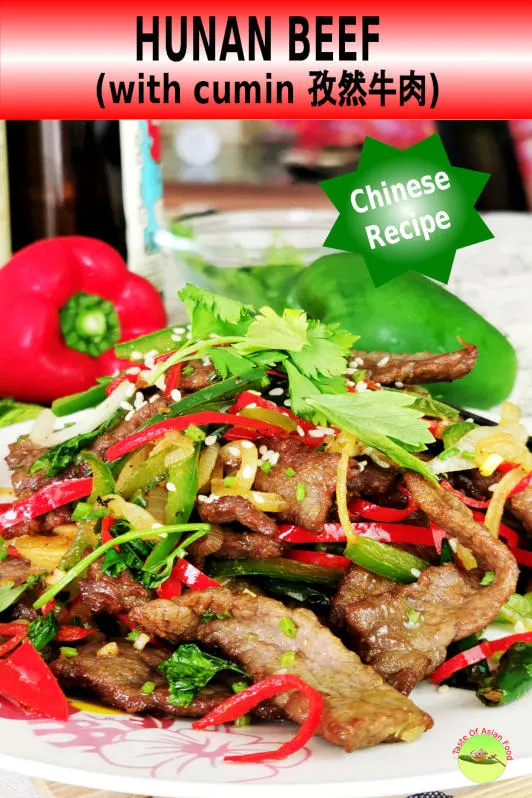
Note: This post may contain affiliate links. Please read my privacy policy for more info. I may receive commissions for purchases made through links in this post. As an Amazon Associate, I earn from qualifying purchases.
The main difference between Hunan and Szechuan cuisine
Although Szechuan cuisine is also hot and spicy, it is different from Hunan cuisine. Szechuan cuisine uses Szechuan peppercorn abundantly and usually has more sauce compared to Hunan cuisine. The Hunan cuisine lacks the numbering filling of the peppercorns, but often added with chili pickles that are slightly sour and salty.
How to cook Hunan beef with cumin
Part 1 – Prepare the beef for stir-fry
How to slice the beef paper-thin
Sirloin is the best cut for stir-frying. If you prefer the cheaper cuts, you can consider using topside or flank steak. The beef will still turn out to be soft & tender if you follow the basic principle as below:
- Cut the beef across the grain.
- Sliced the beef thinly. You can do so easily by cutting the beef when it is in a half-frozen state. When the beef is half-frozen but still able to cut through by applying force, you will be able to cut it like slicing vegetables.
- Add a small amount of baking soda to the beef. Baking powder is traditionally used to tenderize any meat.
The marinade for beef stir-fry
Marinate the beef with light soy sauce, dark soy sauce, Shaoxing wine, oyster sauce, salt, sugar, cornstarch, water, and oil. These are the common seasoning ingredients to marinate any meat in Chinese cuisine. Every chef has a preferred combination and will vary from one person to the other.
The following information is useful if you decide to create your own marinade.
- Light soy sauce is for saltiness and umami.
- Dark soy sauce provides the color and a caramelized taste.
- Shaoxing wine can be substituted with dry sherry. You can omit it if you are a non-alcoholic.
- Oyster sauce is also for flavor. (Some recipes omit it)
- Sugar helps to balance the saltiness and helps to caramelize the surface. You can skip it if you want to reduce sugar intake.
- Baking soda is useful to tenderize the beef.
- Cooking oil helps to prevent drying during marination. It is, therefore, should be added last.
- Beef is hungry for water. Water helps to keep the meat soft and tender.
- Cornstarch helps to crisp up the surface for a better mouthfeel. It also holds the liquid and water of the marinade to the beef.
You can make changes to the basic formula once you understand the functions of each seasoning ingredient.
You only need to marinate the beef for 20 to 30 minutes since it has been cut into thin slices.
Part 2 – The aromatics and vegetables
The aromatics for the beef are ginger and garlic. This combination is widely used in various Chinese cuisine.
The chilies
Hunan cuisines are hot and spicy. The used the local fresh red chili, dried chili, chili pickles, and the small chili 小米椒 are common. If that is too hot for you, you can replace the chili with bell pepper. Scale up or down the amount of chili to suit your taste.
It is a good idea to add some onions. It offers an excellent contrast to the soft and tender beef.
If you can get the traditional chili pickles, cut a few to flavor the Hunan beef with cumin. It is hot, sour, and salty and is a traditional ingredient for Hunan dishes.
Cumin
I prefer to use ground cumin. You can substitute it with fresh cumin seeds. Toast the cumin seeds lightly in a pan without oil. Set aside when it becomes aromatic.
The mouthfeel is very different when you bite the cumin seeds to feel the intense flavor. I like a more subtle cumin flavor and therefore opt for the ground cumin.
Other vegetables
Garlic sprout (蒜叶) is a common vegetable in Hunan cuisine, I can’t find it where I leave, and I have left it out form this Hunan beef with cumin recipe. If you like to use something similar, leek and celery ar the closest alternative
Coriander
Separate the coriander stem from the leaves. I like to cut the coriander stem finely so that they will stick all over on the meat. Keep the coriander leaves as garnish. It can be substituted with scallion for those who do not like the flavor of coriander.
Part 3 – How to stir-fry Hunan beef with cumin
Once you have completed the mise en place, stir-frying is completed within five minutes.
Here are the steps:
- Heat a large ladle of cooking oil into the wok. The amount should be sufficient for deep-frying.
- Add the marinated beef into the oil. Stir the beef slices briskly with the chopstick to break up any beef sliders that stick together, and prevent from sticking to the wok.
- Fry over medium to high heat until the surface is charred slightly. It does not matter if beef is not entirely cooked since we will stir-fry the meat again with the vegetables. The whole process may take less than a minute.
- Pour the beef through a wire mesh strainer to drain the excess oil. (If you do not like deep frying, pan-fry the beef with a non-stick pan, until the edges are slightly charred.)
- Leave about two tablespoons of oil in the wok. Stir fry the onions, ginger, and garlic until aromatic.
- Now add the chilies and stir fry until it is no longer raw.
- Add the cumin, cooked beef, coriander stem. Flash fried over high heat for 20 seconds.
- Dish out and garnish with white sesame seeds and coriander leaves.
Will deep frying the beef take up a lot of oil?
If you are concerned about consuming too much oil, I have some good news about deep frying.
Since I am curious about how much oil will be absorbed by the beef, I did a small test to find out the result.
I measured 250 g of cooking oil and heat in a wok. After deep frying all the beef, I measure the amount of leftover oil again. The amount was 235 grams. The difference before and after is 15g.
That means deep-frying does not take up plenty of oil. Of course, there is some debris left from the beef, but it serves as a guideline on how much oil is actually consumed by deep frying the meat.
You can use the leftover oil to deep-fry or stir-fry other foodstuffs. You can pass it through a cloth bag or filter with a kitchen paper towel to remove the debris.
Not a fan of cumin?
If you are not a fan of cumin, here is another Hunan beef stir fry with chili that you may want to try.
It is an excellent alternative to cumin beef. The preparation and cooking process is nearly identical to the Huna beef with cumin. It is called Hunan beef with chili pepper 小炒黄牛肉.
The method of preparation is quite similar to cumin beef. You can use the same marinade for the meat, with some minor changes in the vegetables that you use.
The ingredients and method of preparation are added to the note section of the recipe card below..
The significant difference is the inclusion of pickled chili peppers. I have included an image to show it to the shopkeeper at the Chinese grocery shop. If you can’t get it, just use the regular chili or bell pepper.
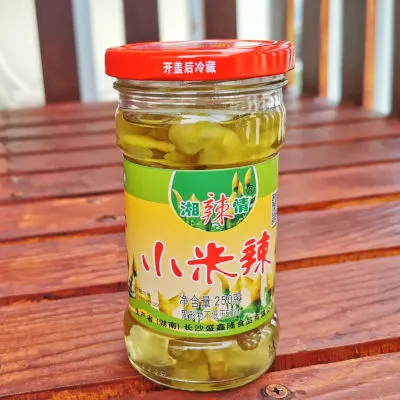
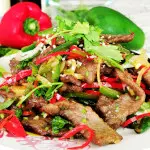
Hunan beef with cumin
Hunan beef with cumin has a hot and spicy taste with a combination of spices and chili peppers. Hunan cuisine is one of the eight great cuisines of China. Today I will pick Hunan beef with cumin for dinner.
Ingredients
(A) For marinating the beef
- 300g beef
- 1 tbsp light soy sauce
- 1/2 tsp dark soy sauce
- 1 tbsp Shaoxing wine
- 1 tsp oyster sauce
- 1/4 tsp salt
- 1/2 tsp baking soda (optional)
- 1 tbsp cooking oil
- 2 tsp cornstarch
- 2 tbsp water
(B) Others
- 4 slices fresh ginger
- 2 cloves garlic, coarsely chopped
- 60g (2 oz) red chilies (4 medium-sized chilies)
- 60g (2 oz) green chilies (4 medium chilies)
- 3 bird's eye chili, (or use pickled chili pepper 泡椒)
- 100g onion (one medium onion, sliced)
- 1.5 tsp ground cumin
- 2 tbsp finely cut coriander stalk
- White sesame and coriander leaves to garnish
- Sufficient cooking oil to fry the beef
Instructions
- Cut the beef into thin slices across the grain.
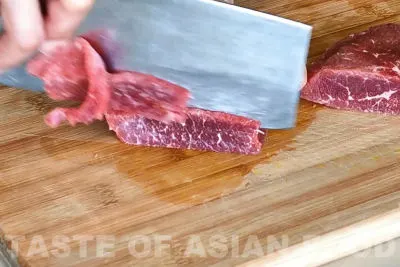
- Combine with all the ingredients in (A). Let it marinate for half an hour.
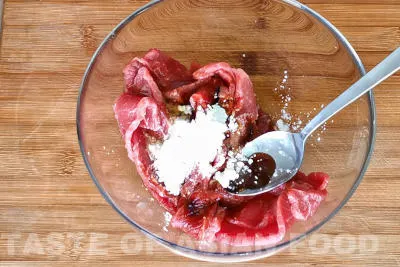
- Deep-fry the beef over medium to high heat until just cooked. Drained.
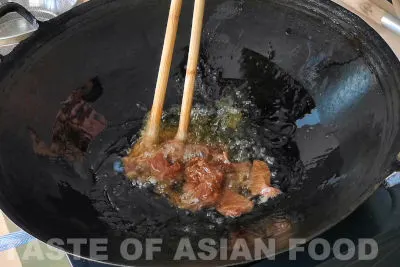
- Leave about two tbsp of oil in the wok. Saute the onion until it turns soft. Add the ginger and garlic and saute until aromatic.
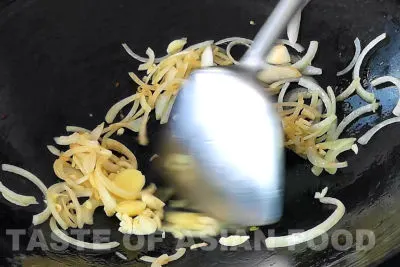
- Add the chilies and stir-fry until no longer raw.
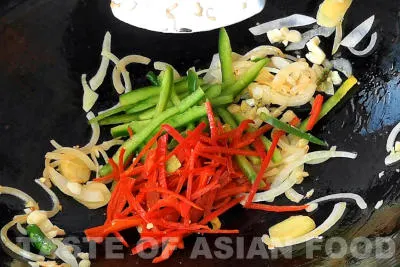
- Add the ground cumin, cooked beef, and coriander stem. Flash fry over high heat for 20 seconds.
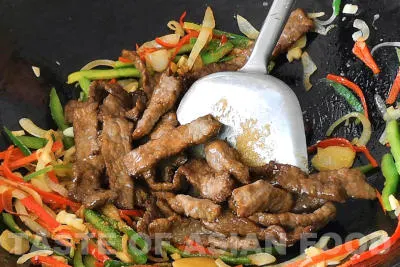
- Dish out and garnish with coriander leaves and white sesame seeds.
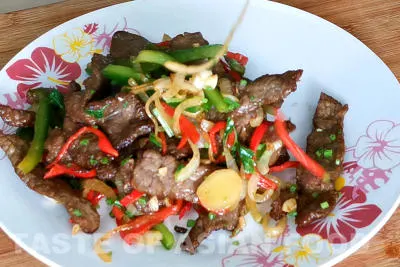
Notes
Hunan stir-fry beef with chili 小炒黄牛肉
Ingredients::
For the beef (A)
Follow the Hunan beef with cumin
Others (B) Change to the following
4 red chilies (60g)
2 bird's eye chili
8 pickled chili pepper (30g)
3 stalks coriander leaves (20g)
2 cloves garlic, coarsely chopped
4 slices ginger
2 stalks garlic sprouts (substitute: 80g celery)
1/2 tsp salt
2 tbsp cooking oil for frying.
Method:
Follow the same method of beef with cumin.
Recommended Products
As an Amazon Associate and member of other affiliate programs, I earn from qualifying purchases.
-
 EXTRA LARGE Organic Bamboo Cutting Board with Juice Groove - Best Kitchen Chopping Board for Meat (Butcher Block) Cheese and Vegetables | Anti Microbial Heavy Duty Serving Tray w/Handles - 18 x 12
EXTRA LARGE Organic Bamboo Cutting Board with Juice Groove - Best Kitchen Chopping Board for Meat (Butcher Block) Cheese and Vegetables | Anti Microbial Heavy Duty Serving Tray w/Handles - 18 x 12 -
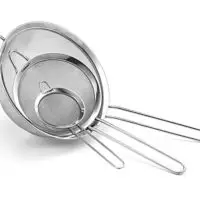 Cuisinart CTG-00-3MS Set of 3 Fine Mesh Stainless Steel Strainers
Cuisinart CTG-00-3MS Set of 3 Fine Mesh Stainless Steel Strainers -
 Joyce Chen 21-9972, Classic Series Carbon Steel Wok Set, 4-Piece, 14-Inch Charcoal
Joyce Chen 21-9972, Classic Series Carbon Steel Wok Set, 4-Piece, 14-Inch Charcoal -
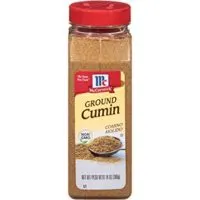 McCormick Ground Cumin, 14 oz
McCormick Ground Cumin, 14 oz
Nutrition Information:
Yield: 2 Serving Size: 1Amount Per Serving: Calories: 1883Total Fat: 114gSaturated Fat: 34gTrans Fat: 0gUnsaturated Fat: 60gCholesterol: 319mgSodium: 4532mgCarbohydrates: 103gFiber: 12gSugar: 15gProtein: 112g
This data was provided and calculated by Nutritionix on 7/30/2020

Eli
Saturday 3rd of April 2021
Great Recipe. I am surprised many people knows about hunan cuisine, which i thought was unknown. What main differences there is between Szechuan Beef and Hunan Beef? I really interested to know what you think. Keep the great job going!
KP Kwan
Sunday 4th of April 2021
Szechuan food more sweet and spicy, while Hunan chicken is plain but hotter.
Laoshi
Friday 26th of March 2021
Thanks for the recipe. I lived in Hunan for a few years and miss Xiao Chao Huang Niuru and...ah...I forget the Chinese for Cumin. Another good dish, very similar to those two, but a bit spicier is Yieshangjiaoniuru , which could be found mostly in Changsha. But you've got that covered with mention of the pickled chilis! Cheers! J
KP Kwan
Saturday 27th of March 2021
Thanks for your comment, I love 小炒黄牛肉 too :)
KP Kwan
Thursday 30th of July 2020
Hi, this is KP Kwan. I am happy to see you in this comment area, as you have read through my recipe. I am pleased to reply to any questions and comments as soon as possible.